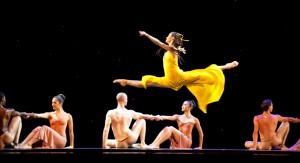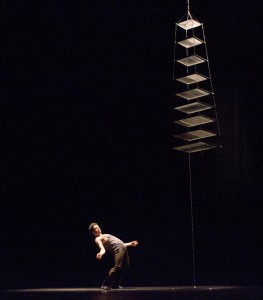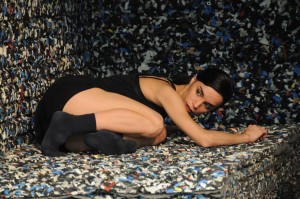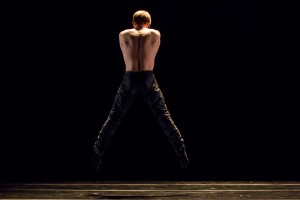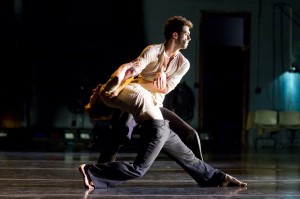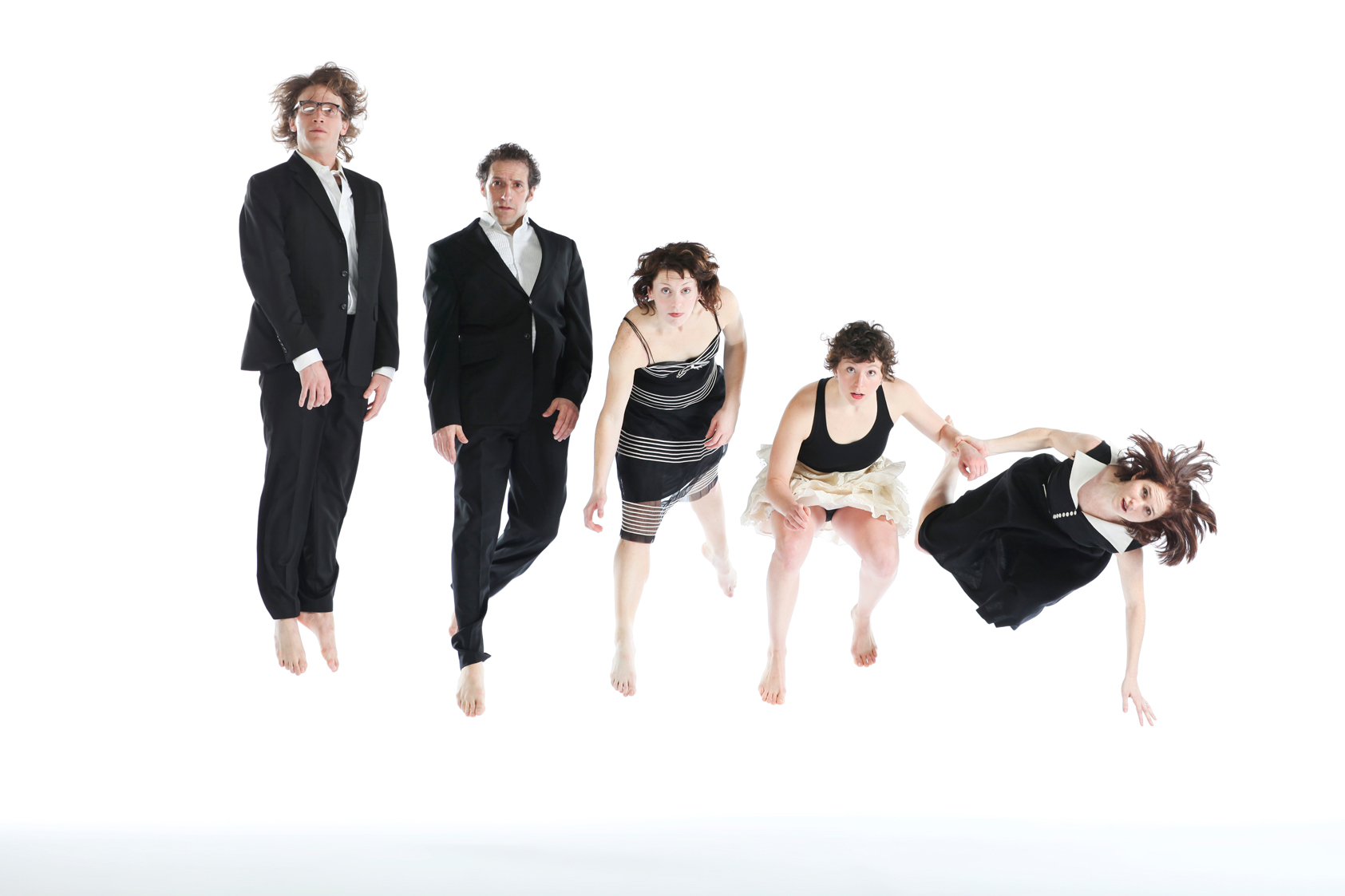 Pointe shoes, electric guitars, muscle and fierce art collide on the MCA Stage this weekend. Karole Armitage, dubbed the “punk ballerina” in 1984 by Vanity Fair Magazine brings her troupe to Chicago as a compliment to the museum’s exhibition This Will Have Been: Art, Love & Politics in the 1980s. After taking a break from her company Armitage Ballet for 15 years while working in Europe, she came back to revive and rename the group Armitage Gone! Dance in 2005. Why gone? “One of the early pieces I did, almost my first piece was called Gone (A Real Gone Dance – 1982),” Armitage said. “I feel like I’m gone from the mainstream, I’m gone from the predictable, I’m often just plain gone. It’s also a hipster term from the 50’s, like ‘she’s a real gone gal’. I liked the multiple meanings. I just didn’t want to take myself so seriously.” This woman that doesn’t take herself seriously, it seems, has done it all. She’s danced for George Balanchine and Merce Cunningham, started her own company, lived in Europe for 15 years choreographing and directing companies, re-started her own company, worked with Mikhail Baryshnikov, Rudolph Nureyev and Michael Jackson, choreographed Madonna’s Vogue video, received a Tony nomination for choreographing the Broadway revival of Hair and is currently choreographing the newest Cirque du Soleil tent show in Montreal. “It’s funny. In my career, I’ve worked with children, singers, dancers a now every kind of acrobat and very shortly I’ll be working with William Wegman on a dog ballet, so I’m adding animals to my list,” she said. “I’ve covered the spectrum now.”
Pointe shoes, electric guitars, muscle and fierce art collide on the MCA Stage this weekend. Karole Armitage, dubbed the “punk ballerina” in 1984 by Vanity Fair Magazine brings her troupe to Chicago as a compliment to the museum’s exhibition This Will Have Been: Art, Love & Politics in the 1980s. After taking a break from her company Armitage Ballet for 15 years while working in Europe, she came back to revive and rename the group Armitage Gone! Dance in 2005. Why gone? “One of the early pieces I did, almost my first piece was called Gone (A Real Gone Dance – 1982),” Armitage said. “I feel like I’m gone from the mainstream, I’m gone from the predictable, I’m often just plain gone. It’s also a hipster term from the 50’s, like ‘she’s a real gone gal’. I liked the multiple meanings. I just didn’t want to take myself so seriously.” This woman that doesn’t take herself seriously, it seems, has done it all. She’s danced for George Balanchine and Merce Cunningham, started her own company, lived in Europe for 15 years choreographing and directing companies, re-started her own company, worked with Mikhail Baryshnikov, Rudolph Nureyev and Michael Jackson, choreographed Madonna’s Vogue video, received a Tony nomination for choreographing the Broadway revival of Hair and is currently choreographing the newest Cirque du Soleil tent show in Montreal. “It’s funny. In my career, I’ve worked with children, singers, dancers a now every kind of acrobat and very shortly I’ll be working with William Wegman on a dog ballet, so I’m adding animals to my list,” she said. “I’ve covered the spectrum now.”
For the MCA appearance, the company’s first since 2008, AGD revives two of Armitage’s 80’s works – Drastic-Classicism (1981) and The Watteau Duets (1985) – and her 2011 piece GAGA-Gaku. The Rogue Ballerina talked with the Punk Ballerina over the phone one Sunday afternoon. Here are some excerpts from our fascinating conversation.
You were born in Wisconsin and grew up in Kansas and Colorado. How did you end up in Switzerland for your first job?
I started taking ballet when I was 4 years old in Kansas with a woman from New York City Ballet, so I was bitten by the magic of the art form. At age 12 or 13, everyone was saying to be really serious, you have to go study full-time, you can’t just take class in Kansas. So I went to the School of American Ballet in NY in the summer. I started going to junior high and high school at the North Carolina School for the Arts. That was the only school in the U.S. both academics and very serious artistic, performing arts training at the time. Summers were in NY. Balanchine fell in love with Suzanne Farrell and she got married to someone else, so he decided to move part-time to Switzerland to escape his lovelorn state and he took all of us from the graduating class with him to Switzerland. That’s how I got there, by a kind of fluke.
And then you went to dance with Merce. What made you want to make that jump?
I always loved doing the leotard ballets by Balanchine ( “Agon”, “The Four Temperaments”) that were really more modern. Psychologically, I was a modern woman. I never felt comfortable, at that age, putting on a tutu and being kind of European. It didn’t make sense to me, so why not do something even more modern, more of my time. I’d never seen Cunningham, I’d never studied modern dance. I went and took a class and I just loved it. It used all of the technique you have in ballet, plus new thinking about movement and music. It was a very exciting place to confront ideas.
Had you always been interested in choreography?
I never really thought about becoming a choreographer or anything. I just thought there was no one doing what I imagined dance to be. There was this oozing gap and I just decided to try and people really liked it. I thought I’d probably only do one piece. It was just an experiment and it just kind of snowballed. I was asked to another piece and another piece, then Paris Opera asked me…it all happened in an organic, unexpected way.
What do you look for in a dancer?
I do love technique. The more skill that way, the better because I think it gives you freedom. You can just carve it and not even think about it. I like virtuosity. I like being able to see the body go to the absolute with new dimensions of movement. Technique is important for that freedom, but only if it is a real person living inside that body that has something to say. I’m not interested in virtuosity for virtuosity’s sake. I really look for personality and imagination. People who are daring, who are willing to participate in a the creative process that the rules are unknown…it takes people who really have courage and are willing to go down these unknown paths. It’s very hard to find dancers who combine all of those qualities. Looking at the whole company, it’s like each person is a different spice and I’m always trying to make a beautiful meal. I don’t want two people that are alike. I want people who are different.
Everything I’ve been reading about Drastic-Classicism says it is an iconic work. Why was it such a big deal in 1981?
There are electric guitars on stage. It used Cunningham technique in the model of Balanchine, so a new vocabulary was born. In addition to that, it really had this raw, theatricality and wildness and jubilation of destruction. That punk feeling. It’s a very youthful piece. It’s very free-spirited. Sometimes the guitars are used as partners. It really was punk, modern dance and ballet put together. That was a very new idea.
With the two revivals, did you change anything?
There’s not a great video, so every step isn’t exactly as it used to be. The dancers in my company weren’t even born yet! That was about the spirit of counter-culture and the joy of being marginal. There is no counter-culture now. Their inner life is different. I don’t know how to recreate literally that spirit and put it into people. They’re different people, so it’s somewhat different. That’s one of the extraordinary things about dance, it’s so of its moment. That’s a great part of its power. It gets you in touch with now. Being in the moment and feeling our time. We change – even though the notes are the same, it comes out different. It’s as close as I knew how to do it. The Watteau Duets is a little easier to revive. It was me and one partner, so it’s quite the same. It’s a relationship from attraction to romance to erotic complicity to neurosis. It’s been fascinating to work with my dancers who technically they’re better than I was on pointe. When they put on their pointe shoes and dance a duet, they take on this “I have to be perfect” ballet mentality. To free them from that and get them to be completely comfortable with who they are and show who they are rather than trying to conform to an idea of what ballet looks like, which was a big process. It’s fascinating to me that it wouldn’t be completely natural to them.
How did you get them to not think that way?
A lot of rehearsal and talking about it from lots of different points of view to help them find it for themselves. It needs a sense of irony and freedom that takes a lot of work to get to be so comfortable and confident and secure in their sense of being a woman. It’s a complicated thing to demand of them. It took quite a bit of work to have them break free from the mold and become completely themselves.
When Vanity Fair dubbed you the “punk ballerina”, what was your initial reaction? Was your career helped by the exposure or did you not want to be labeled?
I think I liked the label. To me it really captured that I was interested in the most fine articulate balletic side of dance, but also the raw, visceral and unpredictable side that comes from rock-and-roll culture. I thought it summed up the spirit of my work in a great way. Honestly, I think it caused a lot of jealousy. I wasn’t in the ballet world, I wasn’t in the modern world and I think it was disturbing to the traditional dance world. But, of course, that’s who I was and who I think I still am. I don’t really fit into these categories. It’s some other different kind of thing. I’m still this odd-ball person. Of course, the publicity was fantastic. If only Vanity Fair was doing more dance. Dance has become more marginalized in mainstream America. It’s just not part of mass culture. We need that exposure. I wish there was more of it.
Armitage Gone! Dance at the MCA Stage, 220 E. Chicago Ave. April 26 – 28 at 7:30 p.m. Tickets are $35. Call 312.397.4010 or visit mcachicago.org.

